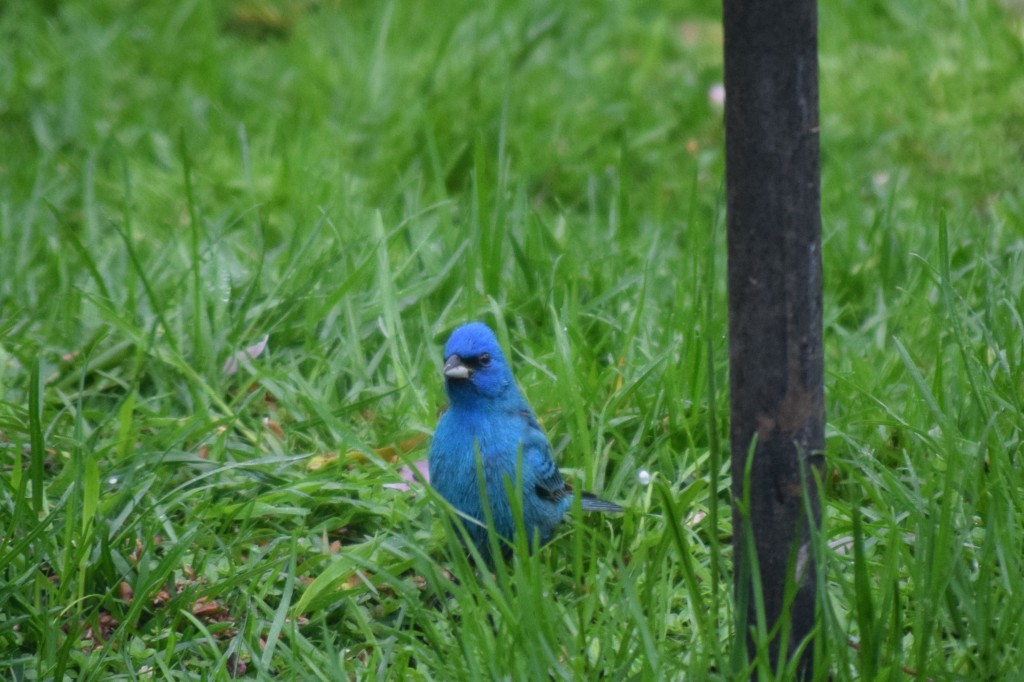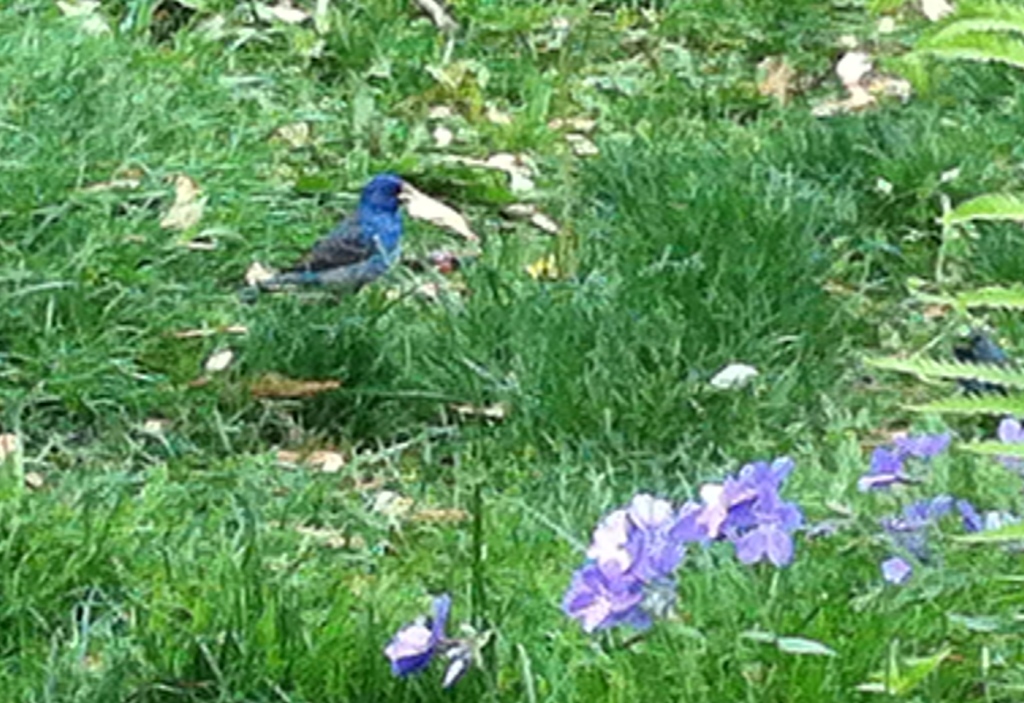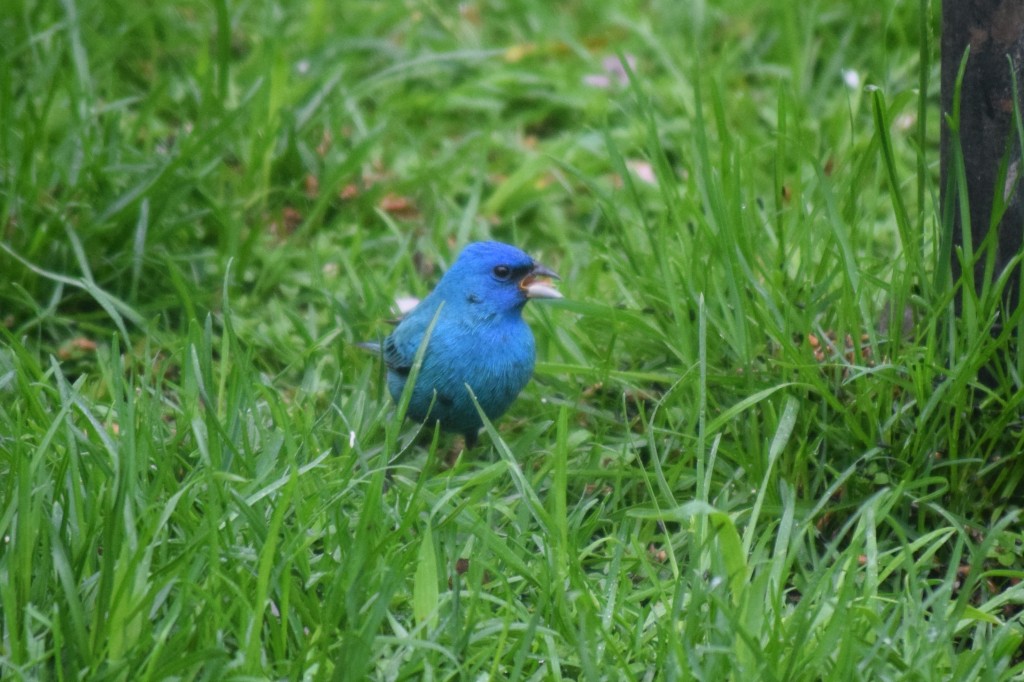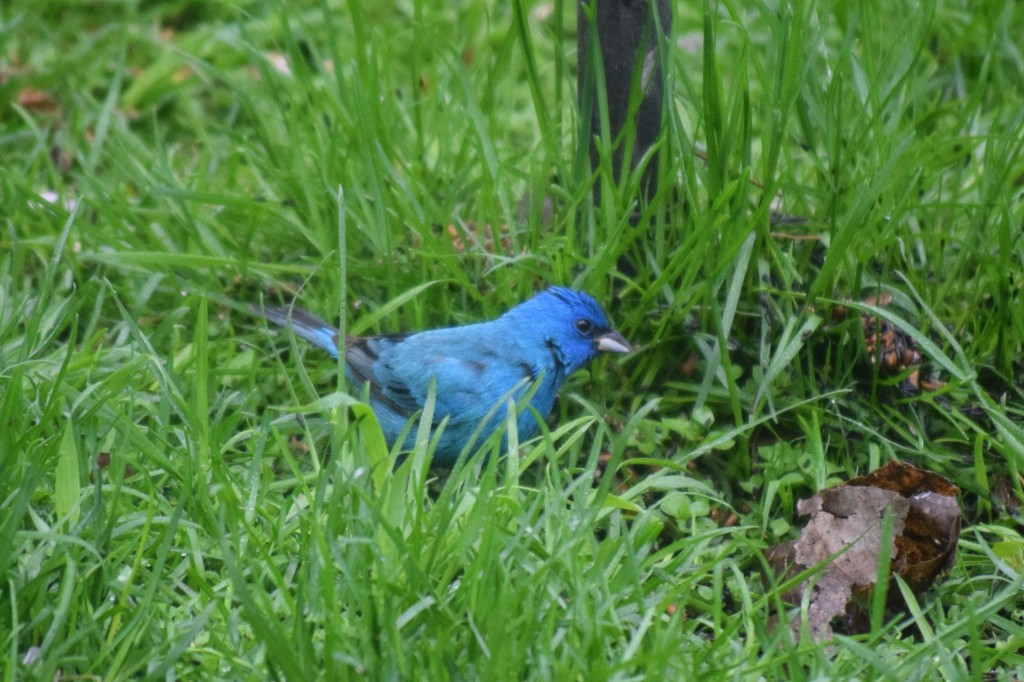An Indigo Bunting for Mother’s Day
According to All About Birds, the website of the Cornell Lab of Ornithology, Indigo Buntings are common. That has not been our experience, however.

Maybe three years ago Judy and I saw an indigo bunting foraging for seeds in the back garden. These are small birds, about the size of a sparrow or goldfinch, but what they lack in size they make up for with the most amazing electric blue color.

Judy grabbed her camera and got a single shot that was so fuzzy the bunting could have been a tiny blue Sasquatch. It was a tantalizingly brief visit, and ever since then we have been yearning for the Indigo Bunting to return.
To attract Indigo Buntings, let your flowers sow their seeds all around the lawn. Hedges and brushy or weedy areas are a plus, but neat weedless lawns are a turnoff. I’ve been spreading white millet on the ground, and you can also tempt them with thistle and nyjer seed (not surprising, since they are just small finches with a terrific sense of fashion).
If you have other birds ground feeding in your garden you are more likely to attract Indigo Buntings, who will want to get in on the grub.

Anyhow, on Mother’s Day an Indigo Bunting appeared in the back garden. He made himself at home and stayed for the whole day, allowing Judy to get a decent number of pictures. Their color is so outlandish and unusual I can’t help but think they are completely out of place in a Midwestern suburban garden.

I hope this one Indigo Bunting brings his friends and that they all stay a good while. But if we never see him again, he did make an outstanding Mother’s Day present.

Indigo Buntings are vigorous singers – here’s a link to some recordings.
Have you ever had Indigo Buntings visit your garden?





Well, I’m jealous….
I’ve gotta say, we feel pretty euphoric after waiting years for this bird to show up again.
How lucky you are! I haven’t seen one in years, certainly never in my backyard. Add to me to the jealous list.
We do feel lucky!
What an extraordinarily beautiful creature. I’ve never seen one in either of my NC gardens.
They really are like little flying sapphires.
I love these birds! I’d like to start attracting more birds to the garden. Growing up we used to grow gourds to house purple martins. I’m not sure that ever actually worked, but perhaps I can start the tradition again. Good luck with the bird watching!
Another option is to grow a cherry or crabapple tree or shrubs with small berries.
Thanks for the tips!
I have not!! But I would love for one to visit as that is the most stunning bird! WOW!!! Did I mention that every street in my neighborhood is named after a bird?? Bunting being one of them!! Wonderful photos Jason! Nicole
Well, then it sounds like your neighborhood should be perfect for birdwatching!
They are not a common bird here either nor one I have ever seen in person….and I have the ideal conditions as my meadow is perfect and it borders an open woodland…maybe someday. Sadly the bluebirds are not around nor are the swallows as much due to high numbers of house sparrows taking all the nesting boxes.
That is very sad, especially about the bluebirds.
Jason, thanks for the nice welcome back! Really enjoyed reading about your blue indigo bunting. When we lived in our previous house, a few Kms from where we live now, we saw a blue indigo bunting in our backyard. It stayed for one day, sitting in a pine tree, and came back exactly a year later and we happen to see it again. Just stayed the one day again, We assumed it was just passing through. And this was early May. Such a treat. Hope yours will stay!
I hope so too, but you are probably right that they just pass through.
Nothing like looking into the garden and seeing a sparkling jewel flitting about. We get one or two every year at our feeders during migration. Always appreciated.
The Indigo Bunting is like a jewel – a flying little sapphire!
Beautiful bird and photos. I have never seen one either in the Midwest or the Northeast. Thank you for sharing. 🙂
You’re welcome!
Just had one yesterday in my central Maine backyard. I almost jumped for joy. I would have loved to have gotten a picture of the little beauty, but alas, he did not stick around. What a lovely Mother’s Day present for you and your wife. And, yes, good pictures!
We were lucky we had the camera right there on the porch with us!
I’ve never seen one here. What a nice surprise for you!
It certainly was a surprise!
Oh how I wish I’d ever seen one!! So gorgeous…. the most “blue” that ever visits are blue jays. Never even seen a bluebird *sigh*
We never see bluebirds in our garden, either.
Wow, what a colour; looks like a sparrow that’s been dipped in blue dye, it just doesn’t look real!
That’s my reaction exactly!
I just saw them when photographing warblers this year with the birders. They are beautiful birds. My understanding is birds like this visiting gardens has to do with the cold spring start. More and more unusual birds are visiting gardens in the last two years because of lack of available food. A warbler in my garden was unusual too.
Well, I guess we benefit from their hunger. But at least our feeders are helping with a real need.
Thanks for sharing. Rose Breasted Grosbeaks (from your previous post) feeding with the usual sparrows and juncos. We have a new cardinal pair that have found our yard as well.
I love Cardinals, and I’m glad they live here year-round.
Wow …. that is such a shocking colour. It looks like a paint advert. What great birds you are getting to see.
It’s really fun every spring.
Stellar jays are as close as we get. They are big, blue and brash and plentiful enough that we take them for granted. I’m sure if we saw one only once in a blue moon, we would celebrate the appearance. Rarity is like that.
Very true.
Nice. Yes, we usually see a few each year. Not many, though. Last year was the first time they came to the feeders. I haven’t seen any yet this year. Judy got some great photos–great Mother’s Day present!
I’m still waiting to see some Cedar Waxwings!
Hello Jason, you have the most amazing birds in your garden, all vibrantly coloured, all shapes, sizes, personalities and appetites. I really am envious when you compare them to the basic robins, blackbirds and magpies we manage.
The really amazing birds are not typical, but I am really grateful for the ones we have.
I’ve never seen one but I’d like to. That’s a beautiful color. Imagine if he landed in a blooming forsythia!
Wow, what an image!
Jason, what an exciting bird to visit, I can imagine the thrill of seeing this bird in your own garden after waiting so long.
We really were very excited. Our son was with us at the time and he thought we were nuts.
Just electric, that blue! When I look at the gorgeous birds on your blog, I wonder why we have so few very brightly coloured birds in Europe, in comparison with N. America. Duller colours would (I imagine), disguise birds from predators better. Have you a theory, Jason?
The bright colors are a means to attracting a mate, and are taken as a sign of general health and vigor. This is why the males are usually so much more colorful than the females. Though this begs the question, since some birds don’t use bright colors to attract a mate, so I guess I really don’t have an answer. Incidentally, the male snowy owl attracts a mate by performing a “shuffle dance” while holding a dead lemming in its beak. I’m really glad not to be a snowy owl.
How beautiful! I’ve never seen one of these indigo wonders here in Toronto. Lucky you.
This is only the second time we’ve seen one.
A blue bird of happiness!
Very much so!
What a heavenly visitor for mother’s day….awwww…if only they came here!xxx
I’d send you some if I could!
We had one visit in North Dakota last year and I was very excited, they are extremely cool looking little birds.
And thank you for the awesome and humorous post! Between the “tiny blue Sasquatch” and “they are just small finches with a terrific sense of fashion”, you had me laughing out loud.
What a beautiful color!
How lucky to see this lovely creature (and Happy Mother’s Day to Judy). I’ve seen only one and it was in my former garden.
I wonder where it is that these birds are common. I’ve never seen one here (but I sure would love to!). When I see flashes of blue flying through my garden, they are almost always blue jays.
A birder friend tells me they are up in the trees if you know how to listen for them.
Wow! What a gorgeous bird. Like the others I have to wonder: where would these guys be common? I’ve never seen one before…. so thank you very much for sharing these photos!
A birder friend says they stay in the trees but you can find them if you learn their song.
Oh, what a beauty! Thanks for including the link to their singing as well.
It’s a gorgeous bird, isn’t it?